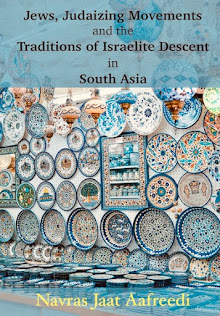
Oleh: Farzand Ahmed, India Today, 6 November 2006
http://unseenhands.wordpress.com/2009/04/04/inikah-suku-israel-yang-hilang/Studi baru-baru ini telah menemukan bahwa asal-usul suku Afridi Pathan di sebuah kota kecil bernama Uttar Pradesh berasal dari ‘suku hilang’ Israel yang sesuai dengan Bibel. Namun suku Pathan tidak bersedia menerima diri mereka sebagai Yahudi. Malihabad, sebuah kota kecil yang terkenal akan buah-buahannya, di daerah pinggiran Lucknow, akan menarik perhatian Anda. Tempat yang mahsyur dengan buah mangga Dussheri yang manis dan harum itu telah melahirkan beberapa syair Urdu dan Persia terindah. Dan pernyataan tersebut tak berakhir di situ. Kota berdebu itu kini dianggap memiliki sesuatu yang dapat ditelusuri hingga masa Bibel. Di antara penduduk Malihabad terdapat sebuah suku berperawakan tinggi, berkulit kuning langsat, dan bertubuh tegap, yang menyebut diri mereka sebagai penyair dan prajurit Afridi Pathan. Selain itu, sebuah panah raksasa yang terletak di gerbang masuk kota didedikasikan untuk Bab-e-Goya, seorang penyair dan prajurit terkenal. Namun bukti-bukti yang berkembang menyiratkan bahwa leluhur mereka bukanlah Muslim tapi Israel dan mereka sebenarnya bukan berasal dari wilayah Afghanistan-Pakistan tapi ternyata merupakan salah satu ‘suku hilang’ Israel. Di Malihabad, di jantung kota Uttar Pradesh, mereka sangat menonjol dengan ciri-ciri fisik mereka yang unik.
Kini sebuah studi yang dilakukan oleh salah satu anggota suku mereka sendiri, Navras Jaat Aafreedi, yang dipublikasikan baru-baru ini dalam bentuk e-book berjudul “The Indian Jewry & The Self-Professed ‘Lost Tribes of Israel’ in India”, menelusuri garis silsilah mereka hingga ke salah satu ‘suku hilang’ Israel. Navras mengatakan, “Tujuan utama penelitian ini (untuk gelar doktor dari Universitas Lucknow) adalah untuk menelusuri leluhur suku Afridi Pathan.” Untuk membuat studinya lebih kredibel, ia mendapat bantuan dari tim peneliti internasional termasuk Profesor Tudor Parfitt, direktur Centre of Jewish Studies di Universitas London, dan Dr Yulia Egorova, seorang ahli bahasa dan sejarah dari Rusia. Tim tersebut mengunjungi Malihabad dan mengumpulkan sampel DNA dari 50 pria Afridi yang tidak memiliki hubungan secara paternal, guna memperkuat informasi mengenai silsilah Israel mereka. Para peneliti mempelajari hubungan Israel dengan Pathan di beberapa daerah perbatasan Pakistan serta kaitannya dengan Afridi Pathan di Malihabad, Uttar Pradesh, dan Qaimganj (Farrukhabad), juga dengan suku Pathan di Aligarh, Sambhal, dan Barabanki, di samping suku-suku di Kashmir, Manipur, dan Guntur di Andhra Pradesh.
Para sejarawan dan ilmuwan seperti Profesor S.N. Sinha (mantan kepala departemen sejarah di Universitas Jamia Millia Islamia), dan Profesor V.D. Pandey (kepala departemen sejarah India zaman modern dan pertengahan di Universitas Lucknow), menyatakan bahwa penelitian Navras menjadi studi ‘yang penting’ mengenai Yahudi di India dan hubungannya dengan Uttar Pradesh. Menurut Bibel, terdapat 12 suku Israel. Kerajaan utara terdiri dari 10 suku yang dibuang dan kemudian dianggap ‘hilang’. Empat dari ‘suku hilang’ tersebut telah ditemukan di India: Afridi, Shinlung di Timur Laut, Yudu di Kashmir, dan suku non-Muslim di Guntur. Para sejarawan percaya bahwa Afghan adalah keturunan Israel – nama lain cucu Ibrahim, Jacob atau Yakub. Mereka datang ke wilayah yang dikenal sebagai Perbatasan Barat Laut dan Afghanistan; dan setelah pindah mereka dipanggil Afridan, dalam bahasa Persia berarti ‘baru tiba’ dan karena itu memperoleh sebutan ‘Afridi’. Banyak dari Afridi-Afghan masih mengikuti tradisi Yahudi seperti Sabbath dan khitanan pada hari ke-8 kelahiran bayi. “Ada 3 kelompok utama Israel atau Yahudi di India: Bene Israel (kelompok tebesar), Cochini (kelompok terkecil), dan Baghdadi. Pathan di Malihabad dan Farrukhabad menyebut diri mereka sebagai Bani Israel, yang berarti Anak-anak Israel (Children of Israel). Suku-suku Bani Israel juga ditemukan di Aligarh dan Sambhal, Moradabad.
Perkampungan Pathan-Afridi di Malihabad telah ada sejak tahun 1202, ketika desa Bakhtiarnagar didirikan oleh Mohammad Bakhtiar Khilji. Sebagian besar suku Pathan datang pada sekitar pertengahan abad 17 dan semua suku migran mengambil kepemilikan atas desa-desa di sekitar Malihabad. Namun, gelombang terbesar migran Pathan, terutama Afridi, tiba di Malihabad satu abad kemudian saat terjadi lima invasi Ahmad Shah Abdali antara tahun 1748 dan 1761. Banyak Israel-Afridi di Malihabad dan Qaimganj memperoleh kedudukan terkemuka di bidang peperangan, politik, literatur, dan olah raga. Jika Dr. Zakir Husain, seorang Israel-Pathan, Presiden India ke-3 dan pendiri Universitas Jamia Millia Islamia berasal dari Farrukhabad, Malihabad bangga memiliki Nawab Faqueer Mohammad Khan ‘Goya’ (penyair dan anggota istana Awadh yang kemudian pindah ke Pakistan), Ghaus Mohammad Khan (pemain tenis), dan Anwar Nadeem (artis, penulis, dan penyair).
Terdapat sekitar 1200 sampai 1300 suku Pathan di Malihabad, dan setengah dari mereka, menurut penelitian terbaru, adalah Israel-Afridi. Penelitian tersebut telah menimbulkan kegemparan di antara Afridi Pathan karena mereka tidak bersedia mengakui identitas ke-Yahudian mereka. Tidak seperti suku-suku lainnya yang telah bersedia menyatakan pertalian mereka dengan ‘suku hilang’ Israel, Afridi Pathan bersikap tdiak percaya tentang status ke-Yahudi-annya. Kengganan ini terbukti ketika Qavi Kamal Khan (91 tahun), salah satu anggota suku Afridi Pathan di kota, mengatakan, “Saya telah mendengar bahwa kami memiliki garis silsilah Israel, tapi kami bukan Yahudi. Kami adalah Afridi.” Namun, para sejarawan mempercayai penelitian Navras dapat menjadi tonggak penting dalam penelitian sejarah-genealogis yang berangkat dari Lucknow yang tak dikenal, untuk menemukan kembali pertalian yang hilang dalam perjalanan waktu. Studi tersebut, sekali lagi, membuktikan bahwa dunia ini ternyata adalah desa global.









.jpg)

















